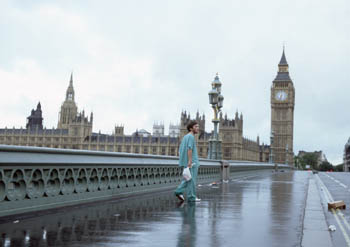![[Metroactive Movies]](http://metroactive.com/movies/gifs/movies468.gif)
[ Movies Index | Show Times | Silicon Valley | Metroactive Home | Archives ]
London Calling: A synthetic plague empties the streets of London in '28 Days Later.'
Anger Management
Humanity rages out of control in '28 Days Later' and 'The Hulk'
By Richard von Busack
IF IT'S THE Summer of Rage at the box office, it's only a reflection of the world offscreen with its wars, a stiffed and disheartened workforce and partisan deadlock from Sacramento to D.C. The Hulk's steroided snarl, like a Henry Rollins struck green with seasickness, is branded on everything but condoms.
Ang Lee's monster movie is the most zeitgeisty picture since The Quiet American. You couldn't ask for a more perfect mascot for U.S. foreign policy. They ought to give free Hulk dolls with every subscription to the Weekly Standard. Yet the British import 28 Days Later, with only a fraction of The Hulk's ad budget, offers a far better essay on the menace of raging humanity.
In 28 Days Later, a deadly synthetic virus called "Rage" gets loose in the population. Jim, a comatose London motorcycle delivery boy (Cillian Murphy), wakes up alone 28 days after the initial exposure. He's been spared the worst of the epidemic, which transformed people into bloodthirsty maniacs. Scriptwriter Alex Garland has spun his tale off everything from J.G. Ballard's speculative fiction to John Wyndham's science fiction novels, in which England gets it in a dozen imaginative ways (why won't someone film Wyndham's novel The Kraken Awakes?). You can count the references to George Romero's politically paranoid Night of the Living Dead trilogy.
But Garland and director Danny Boyle improve on the legend by shortening the incubation period. In a matter of seconds, a previously rational human becomes red-eyed and howling and starts puking blood.
Boyle (Trainspotting) makes this an urgent, nasty digital-video production. He manages expensive-looking apocalyptic scenes on the cheap; the point-and-shoot cameras let traffic be halted just briefly enough to capture a zombie-ruined London under the creamy pink light of dawn. Sights of silent, abandoned streets and the war memorials surrounded with swirls of trash all bring up the hackles. Digital effects can be a liability, though. During the zombie attacks, the too-speedy digital image breaks up; you never can see more than murk and a star burst of scattered pixels.
Jim is nearly chomped by fast-moving zombies when he's rescued by a slayer-type named Selena (Naomie Harris)--a lone woman who has figured out the rules of how the monsters work. The two join a London cabbie (the humane Brendan Gleeson) and his daughter, who have previously taken refuge in the top of a high-rise apartment, barricaded with piles of shopping carts blocking the stairwell.
What's likable here is how Garland and Boyle oppose their feelings about what they call "this diseased little island" England with the thought of the warm things of civilization lost. 28 Days Later pauses to mourn the death of Jim's parents. Boyle catches the image of goldfish in an aquarium, trapped in an inch of water, after giving up most of their habitat to thirsty humans. Hearing news of a fortress north of Manchester, the group leaves this fire, heading into the frying pan of a military bivouac, where the soldiers are on the point of mutiny and worse.
The standard blueprint for the classic 1950s monster movie--as outlined in Peter Biskind's book Seeing Is Believing--posits the Other is a metaphor for the Cold War. Each 1950s horror film, Biskind suggests, plays out the then-current debate between whether nuking the Communists would be a better idea than containing them. In the typical Allied Artists monster picture, infuriated army generals, ready to strike, are opposed by scientists. The eggheads want the alien monster to live for study. At this point, a disinterested civilian enters the picture, uniting the men of war and the men of science. Together, they control the monster the right way, using the weapons of science.
The Hulk is such a peculiar film because it abandons this tried-and-true plan, unchanged since before the Berlin Wall came down. Avoiding the useful movie cliché of the too-angry military, The Hulk has nothing suitable to replace it. Since Stan Lee debuted The Hulk--about a meek scientist who wandered into the gamma rays of a bomb blast--we have had news of much-documented experiments in which both the U.S. and British armies deliberately exposed soldiers to radiation.
Playing that real-life horror out would have had resonance. However, in the Ang Lee movie, military might quells the Hulk. Science--evil and sadistic from the opening credits--creates him and doesn't have a hand in taming him. This may signal the wave of horror movies to come. Suspicious of the lab boys, we trust in the sternness of the generals.
28 Days Later, like the radical George Romero films it is based on, suggests that when it comes to horror, there's nothing as scary as soldiers on the warpath, consumed with wrath. They're more fearful than zombies or atomic Frankensteins; they're more recognizably human when they're out of control.
[ Silicon Valley | Metroactive Home | Archives ]
Copyright © Metro Publishing Inc. Metroactive is affiliated with the Boulevards Network.
For more information about the San Jose/Silicon Valley area, visit sanjose.com.
![]()

Photograph by Peter Mountain
28 Days Later (R; 112 min.), directed by Danny Boyle, written by Alex Garland, photographed by Anthony Dod Mantle and starring Cillian Murphy, opens Friday at selected theaters valleywide.
Send a letter to the editor about this story to letters@metronews.com.
From the June 26-July 2, 2003 issue of Metro, Silicon Valley's Weekly Newspaper.